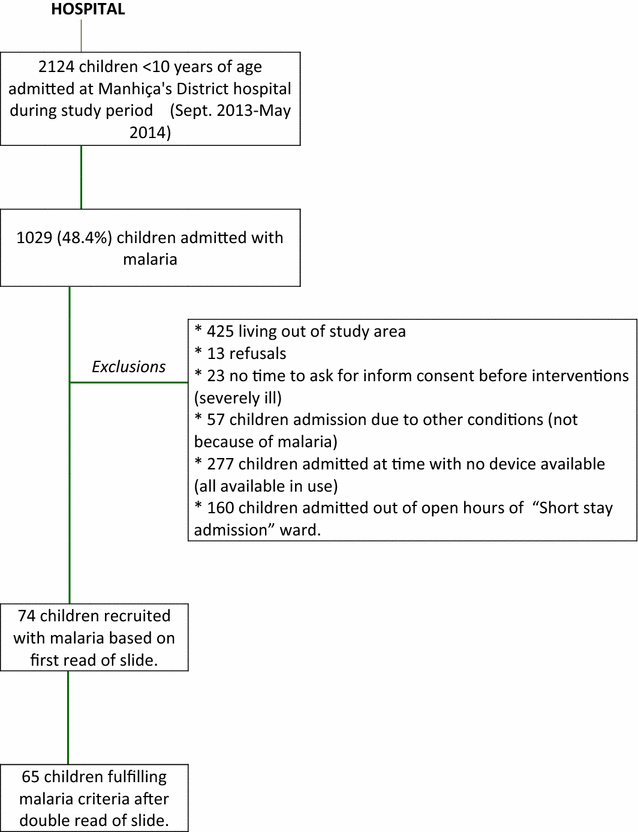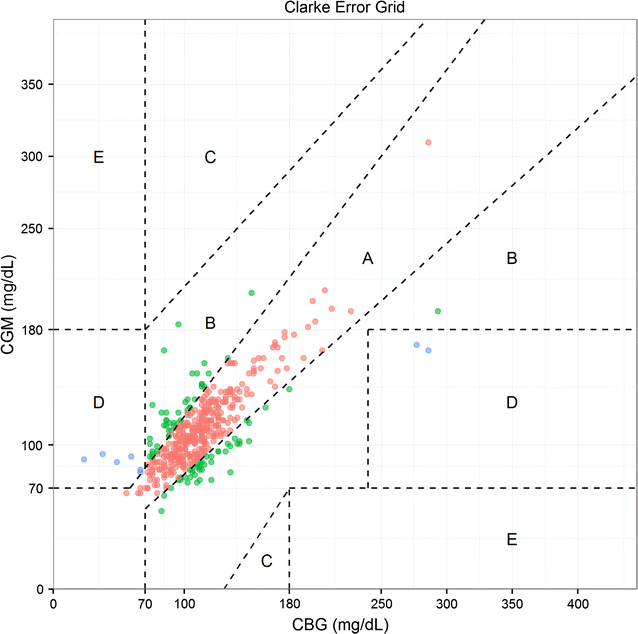Continuous determination of blood glucose in children admitted with malaria in a rural hospital in Mozambique
- PMID: 28464825
- PMCID: PMC5414384
- DOI: 10.1186/s12936-017-1840-x
Continuous determination of blood glucose in children admitted with malaria in a rural hospital in Mozambique
Abstract
Background: Hypoglycaemia is a frequent complication among admitted children, particularly in malaria-endemic areas. This study aimed to estimate the occurrence of hypoglycaemia not only upon admission but throughout the first 72 h of hospitalization in children admitted with malaria.
Methods: A simple pilot study to continuously monitor glycaemia in children aged 0-10 years, admitted with malaria in a rural hospital was conducted in Southern Mozambique by inserting continuous glucose monitors (CGMs) in subcutaneous tissue of the abdominal area, producing glycaemia readings every 5 min.
Results: Glucose was continuously monitored during a mean of 48 h, in 74 children. Continuous measurements of blood glucose were available for 72/74 children (97.3%). Sixty-five of them were admitted with density-specific malaria diagnosis criteria (17 severe, 48 uncomplicated). Five children (7.7%) had hypoglycaemia (<54 mg/dL) on admission as detected by routine capillary determination. Analysing the data collected by the CGMs, hypoglycaemia episodes (<54 mg/dL) were detected in 10/65 (15.4%) of the children, of which 7 (10.8%) could be classified as severe (≤45 mg/dL). No risk factors were independently associated with the presence of at least one episode of hypoglycaemia (<54 mg/dL) during hospitalization. Only one death occurred among a normoglycaemic child. All episodes of hypoglycaemia detected by CGMs were subclinical episodes or not perceived by caregivers or clinical staff.
Conclusions: Hypoglycaemia beyond admission in children with malaria appears to be much more frequent than what had been previously described. The clinical relevance of these episodes of hypoglycaemia in the medium or long term remains to be determined.
Keywords: Blood glucose; Continuous glucose monitor; Hyperglycaemia; Hypoglycaemia; Malaria.
Figures




Similar articles
-
[Usefulness of continuous glucose monitoring system (CGMS) in monitoring glycaemic profile in small children with diabetes type 1].Endokrynol Diabetol Chor Przemiany Materii Wieku Rozw. 2005;11(4):237-43. Endokrynol Diabetol Chor Przemiany Materii Wieku Rozw. 2005. PMID: 16232362 Polish.
-
Malaria-associated hypoglycaemia in children.Expert Rev Anti Infect Ther. 2015 Feb;13(2):267-77. doi: 10.1586/14787210.2015.995632. Epub 2014 Dec 26. Expert Rev Anti Infect Ther. 2015. PMID: 25540871 Review.
-
Abnormal blood glucose concentrations on admission to a rural Kenyan district hospital: prevalence and outcome.Arch Dis Child. 2003 Jul;88(7):621-5. doi: 10.1136/adc.88.7.621. Arch Dis Child. 2003. PMID: 12818911 Free PMC article.
-
Sublingual sugar for hypoglycaemia in children with severe malaria: a pilot clinical study.Malar J. 2008 Nov 23;7:242. doi: 10.1186/1475-2875-7-242. Malar J. 2008. PMID: 19025610 Free PMC article. Clinical Trial.
-
Mini-review: Management of hypoglycaemia in children aged 0-59 months.J Trop Pediatr. 2010 Aug;56(4):227-34. doi: 10.1093/tropej/fmp109. Epub 2009 Nov 23. J Trop Pediatr. 2010. PMID: 19933785 Free PMC article. Review.
Cited by
-
Opportunities for Improving Outcomes in Severe Malaria: The Role of Blood Glucose Monitoring.Am J Trop Med Hyg. 2023 Apr 17;108(6):1079-1080. doi: 10.4269/ajtmh.23-0178. Print 2023 Jun 7. Am J Trop Med Hyg. 2023. PMID: 37068755 Free PMC article. No abstract available.
-
Hypoxemia, hypoglycemia and IMCI danger signs in pediatric outpatients in Malawi.PLOS Glob Public Health. 2022 Apr 26;2(4):e0000284. doi: 10.1371/journal.pgph.0000284. eCollection 2022. PLOS Glob Public Health. 2022. PMID: 36962312 Free PMC article.
-
Temporal Trends of Blood Glucose in Children with Cerebral Malaria.Am J Trop Med Hyg. 2023 Apr 17;108(6):1151-1156. doi: 10.4269/ajtmh.23-0022. Print 2023 Jun 7. Am J Trop Med Hyg. 2023. PMID: 37068750 Free PMC article.
-
Malaria-Associated Acute Kidney Injury in African Children: Prevalence, Pathophysiology, Impact, and Management Challenges.Int J Nephrol Renovasc Dis. 2021 Jul 8;14:235-253. doi: 10.2147/IJNRD.S239157. eCollection 2021. Int J Nephrol Renovasc Dis. 2021. PMID: 34267538 Free PMC article. Review.
-
Dysglycemia in Children with Severe Acute Malnutrition: A Systematic Review and Meta-Analysis.Adv Nutr. 2021 Jun 1;12(3):959-968. doi: 10.1093/advances/nmaa138. Adv Nutr. 2021. PMID: 33179024 Free PMC article.
References
Publication types
MeSH terms
Substances
LinkOut - more resources
Full Text Sources
Other Literature Sources
Medical

